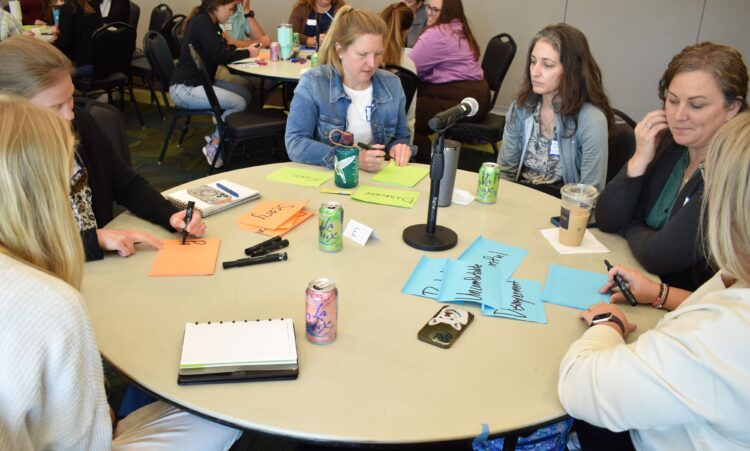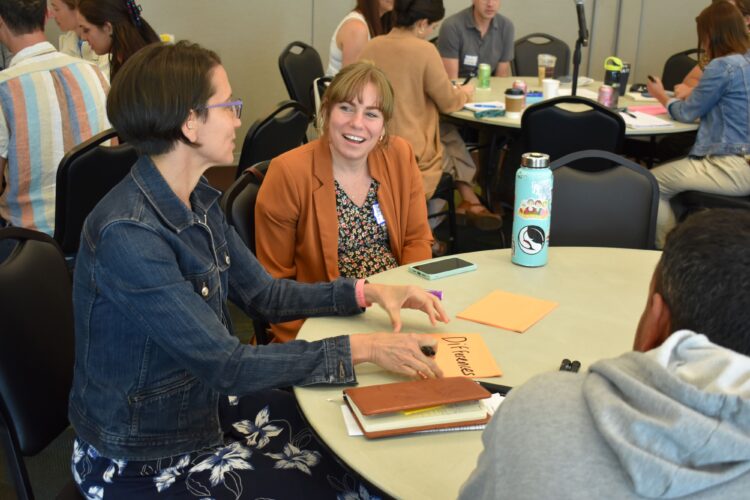By Katie Loesser
The salty breeze billows over glistening sand, which stretches out to meet the gentle laps of the morning sea. A pair of gulls flies overhead, greeting the world with their laugh-like calls. Scattered at the water’s edge is a smattering of treasures – mottled scallops, ribbed cockles, butterflied coquinas – just waiting to be discovered.
The idyllic Florida coast is the largest in the contiguous United States. With abundant recreational fisheries and outdoor opportunities, it is no surprise that over 100 million people flock here each year to visit, and over 21 million others call the beautiful state home.
“I moved to Florida in 2020 and saw that the state was so reliant on the environment, in particular the coastal environment,” said Dr. Nicole Raineault, chief scientist at the Florida Institute of Oceanography. “We’re really at the mercy of the ocean and the weather patterns that come through here for our health and well-being – not only our physical well-being, but our economic well-being too.”

Raineault spent a decade of her career exploring the deep sea. Then in 2021, she began her current role in which she oversees the Florida RESTORE Act Centers of Excellence Program (FLRACEP), a grants program that aims to fund actionable science that informs natural resource management.
“Starting to establish a family here meant I saw a need for making sure the science that’s being done can really support everybody’s family, support people who are living in the state,” she said. “I’m really enjoying working with scientists who are focused on issues that impact our everyday lives.”
One important issue she sees in Florida is recreational fisheries. “Being able to manage fisheries wisely is really critical and there are still some really basic questions that can be addressed through research programs,” she said. “Helping connect those foundational questions back to management is important. That’s part of what our program is trying to do and why co-production in particular is important.”
Co-Producing Actionable Science
Co-production, a collaborative partnership between researchers, resource managers, and other end users, is a method for producing science that is useful and usable to practitioners. The hallmark of this approach is integrating intended end users into the research project team and allowing their needs to drive the process, starting from the project’s inception.
Dr. Sara Zeigler, a researcher with the U.S. Geological Survey’s St. Petersburg Coastal and Marine Science Center, has participated in several projects that used a co-production approach to collaborate with natural resource managers and has found the approach beneficial.

One of Zeigler’s co-production projects focused on the impacts of shoreline changes on piping plover conservation.
“The managers for that project were involved at every stage, and it made the work a lot more efficient,” she said. “Right off the bat that sort of collaboration provided a really rich dataset.”
By bringing her into the field, they showed her places that she otherwise would not have had access to. “Those managers know more about those landscapes than anybody,” she said. “So I learned a ton from them, and their needs were really driving what we’re producing.”
Despite her experience, Zeigler still has questions about how to identify end users with science needs. “A commonality in my co-production-type projects is that the manager kind of came to me or came to my science group with the problem. And so how can I be more proactive about finding it for myself, and not just the manager coming to me?,” she said. “That’s something that I could still learn a lot more about.”
This communication disconnect is a struggle that end users face, too. “I think the biggest aspect that we’ve been looking at right now is knowing where the research is that we need to have,” said Anthony Thomas, the RESTORE Act coordinator for Pasco County’s Office of Strategy and Sustainability.
Thomas, a native Floridian, spent over 20 years in a military and law enforcement career before returning home to Pasco County. As an end user, he depends on research results to enact policy that promotes sustainability in his county, but not being directly connected to the research community can make his job challenging.
“We don’t know which [researchers] are doing what and we have no central repository where we can go research this information,” he said. Searching online only yields so much, he added. “I’m doing a random shot in the dark. Unless you know [who to turn to], you don’t know, you would have no clue,” Thomas said.
Bridging the Gap
To help bridge the gap between researchers, resource managers, and other end users, the NOAA RESTORE Science Program, FLRACEP, the NOAA National Estuarine Research Reserve System Science Collaborative, Florida Sea Grant, and and the University of Florida’s Natural Resource Leadership Institute partnered together to host a two-day workshop in St. Petersburg, Florida in May of this year. The workshop gathered individuals from across the state to learn about science co-production and discuss best practices to improve science for natural resource management in Florida.
During the two-day event, 51 participants, including Zeigler and Thomas, were assembled into small groups and engaged in a range of activities, giving them the chance to not only learn about the process of co-production and how to effectively implement it, but to also build relationships with each other.
“I really appreciated how the workshop was able to get people to interact with each other, because a lot of times that doesn’t happen,” Raineault said. “I thought that it offered a lot of opportunity to have people kind of have fun with the process and learn from working together. And I think and am hopeful that that’s going to really benefit our program by helping people apply those skills to their future grants.”

Thomas echoed the value of bringing everyone together into the same room. “One of the biggest takeaways I took from the co-production meeting is you have to be able to take that science view to where it meets with our end user view,” he said. “It’s almost like having a thesaurus of words that can match, because I need to be able to understand what you do and see your view and you need to be able to understand what I’m trying to do and see my view. And so it’s having that team effort.”
In one session, participants gathered at round tables to design a co-produced research project that addressed a problem scenario. With the help of a facilitator, they walked through worksheets outlining the process of identifying and involving end users.
“It was interesting to see my group immediately went towards, ‘this is what we should do,’ instead of sort of breaking it down the way the worksheet wanted us to, in terms of, ‘who should be involved and why?’” Zeigler said.
“I think it is our instinct to immediately jump in, especially when we have a specific skill set, and say, ‘we’re going to use this skill set to do this for these people.’ So it kind of forced us to take our time and break it down into these categories [of interested and affected people], which I found to be really helpful,” she said.
Remaining Challenges
Rotating between stations representing the different stages of a collaborative project, participants worked together to brainstorm roadblocks that arise during the co-production process as well as potential solutions to address them. For instance, to help researchers know about manager and other end user needs, participants recommended going to them where they’re at – whether it’s meeting fishermen at the docks, attending a community group’s meetings, or some other setting.
Yet, some challenges remain difficult to navigate. Perhaps one of the more significant ones is aligning the varying specificity and timelines of management decisions and research.
“A lot of these decisions that [managers] need to make are a little bit vaguer than sort of what the approach calls for,” Zeigler noted. Then, “if they know that there’s a decision that must be made, it needs to be made in a year or less and not that five years span that comes with a lot of research [projects]. So fitting into that pattern I found to be a little difficult,” she said.
One way Zeigler found to mitigate this challenge was focusing her research around an underlying management issue rather than a single, specific decision happening at a specified time.
It is also important to consider what those potential management decisions look like and what is the most effective way to support them. “In some cases it’s going to be very appropriate to have that really in-depth co-production and others less so,” Zeigler said.

Further, it can be difficult to fit the relationship building that is foundational to effective co-production into funding cycle timelines. A common theme was the length of time involved in developing effective relationships, and that it can be challenging to make those connections within the timeframe of an open call for proposals.
“One of the challenges for researchers is until they know there’s going to be a call that will support this kind of science, it might be hard for them to develop those relationships,” Raineault said. “Some will have established them through years of other funded research, but I think giving people a little bit of time to do that research and relationship building is probably important.”
While it might not be a one-size-fits-all solution, co-production is showing promise and garnering excitement across sectors, including funders. “Co-production is part of our 10-year strategic plan, and that was something that was very intentional,” Raineault said. “So I think in the next 10 years, we’ll only see more of that through the FLRACEP-funded projects.”
Cover photo: Participants gather at the USF University Student Center in St. Petersburg, FL for a two-day co-production workshop hosted by the NOAA RESTORE Science Program, FLRACEP, the NOAA National Estuarine Research Reserve System Science Collaborative, Florida Sea Grant, and University of Florida’s Natural Resource Leadership Institute. Photo credit: Chris Sharp and Nicole Mendez Pena, Florida Institute of Oceanography
 Official websites use.gov
A .gov website belongs to an official government organization in the United States.
Official websites use.gov
A .gov website belongs to an official government organization in the United States.
 Secure .gov websites use HTTPS
A lock or https:// means you’ve safely connected to the .gov website. Share sensitive information only on official, secure websites.
Secure .gov websites use HTTPS
A lock or https:// means you’ve safely connected to the .gov website. Share sensitive information only on official, secure websites.